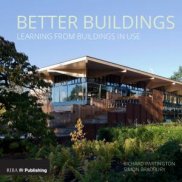Better Buildings: Learning from buildings in use - review
Richard Partington & Simon Bradbury - 'Better Buildings: Learning from buildings in use'
RIBA Publishing (Mar 2017)
This book takes as its foundation the general acceptance that architects rarely return to the buildings they design to assess their performance-in-use. This is despite the demand for energy efficient design steadily increasing.
The authors believe a vital part of the architect’s role is talking to users, observing how the buildings work and have been adapted, and assessing whether the environments they have created are actually enjoyable places to live and work.
‘Better Buildings’ is a fully-revised edition of a 2007 book ‘Sustainable Architecture’, which postulated that spirits could be lifted as well as the planet being saved by building design that adhered to sustainable principles. By stepping further with this new book, and examining the methods that can be used to observe how sustainable buildings work in occupation, the authors provide architects with the necessary inspiration and tools to deliver better sustainable design.
The authors address the widely-held perception that there are barriers to undertaking effective follow-through after handover; providing ideas and strategies for overcoming problems in practice.
The book is divided into two sections, starting with a selection of short essays provided by industry thought-leaders such as Bill Gething (who has written extensively on the subject in books like ‘Design for Climate Change’), and Mark Lumley of Architype.
The second section provides a series of illustrated case studies of aesthetically-attractive and environmentally ground-breaking projects, such as the Woodland Trust HQ in Grantham, and WWF’s Living Planet Centre in Woking. In each it explores how the architectural design solutions delivered the low-energy performance promised, providing accounts that are also honest about where they fell short.
The book does not prescribe one particular method over any other, instead it seeks to examine the balance that designers have sought between technical surety and formal invention.
Overall, it is a well-presented and comprehensive book, which joins the growing corpus of titles examining this vital area of the industry. Students and professionals would do well to check it out.
[edit] Related articles on Designing Buildings
- An Introduction to Passive House - review.
- Bill Gething and Katie Puckett - Design for Climate Change.
- Building performance evaluation.
- Building Revolutions - review.
- Closing the gap between design and as-built performance.
- FutuREstorative - review.
- Performance in use.
- The building as climate modifier.
Featured articles and news
Infrastructure that connect the physical and digital domains.
Harnessing robotics and AI in challenging environments
The key to nuclear decommissioning and fusion engineering.
BSRIA announces Lisa Ashworth as new CEO
Tasked with furthering BSRIA’s impressive growth ambitions.
Public buildings get half a million energy efficiency boost
£557 million to switch to cleaner heating and save on energy.
CIOB launches pre-election manifesto
Outlining potential future policies for the next government.
Grenfell Tower Inquiry announcement
Phase 2 hearings come to a close and the final report due in September.
Progress from Parts L, F and O: A whitepaper, one year on.
A replicated study to understand the opinion of practitioners.
ECA announces new president 2024
Electrical engineer and business leader Stuart Smith.
A distinct type of countryside that should be celebrated.
Should Part O be extended to existing buildings?
EAC brands heatwave adaptation a missed opportunity.
Definition of Statutory in workplace and facilities management
Established by IWFM, BESA, CIBSE and BSRIA.
Tackling the transition from traditional heating systems
59% lack the necessary information and confidence to switch.
The general election and the construction industry
As PM, Rishi Sunak announces July 4 date for an election.
Eco apprenticeships continue help grow green workforce
A year after being recognised at the King's coronation.
Permitted development rights for agricultural buildings
The changes coming into effect as of May 21, 2024.






















